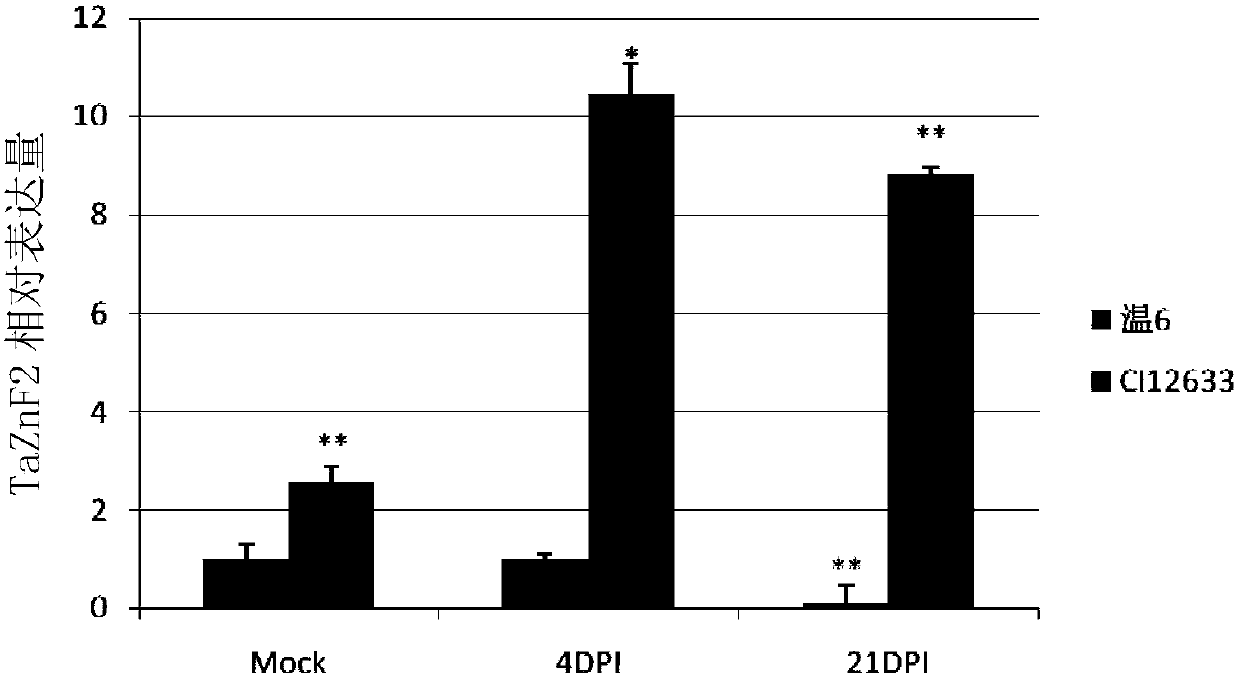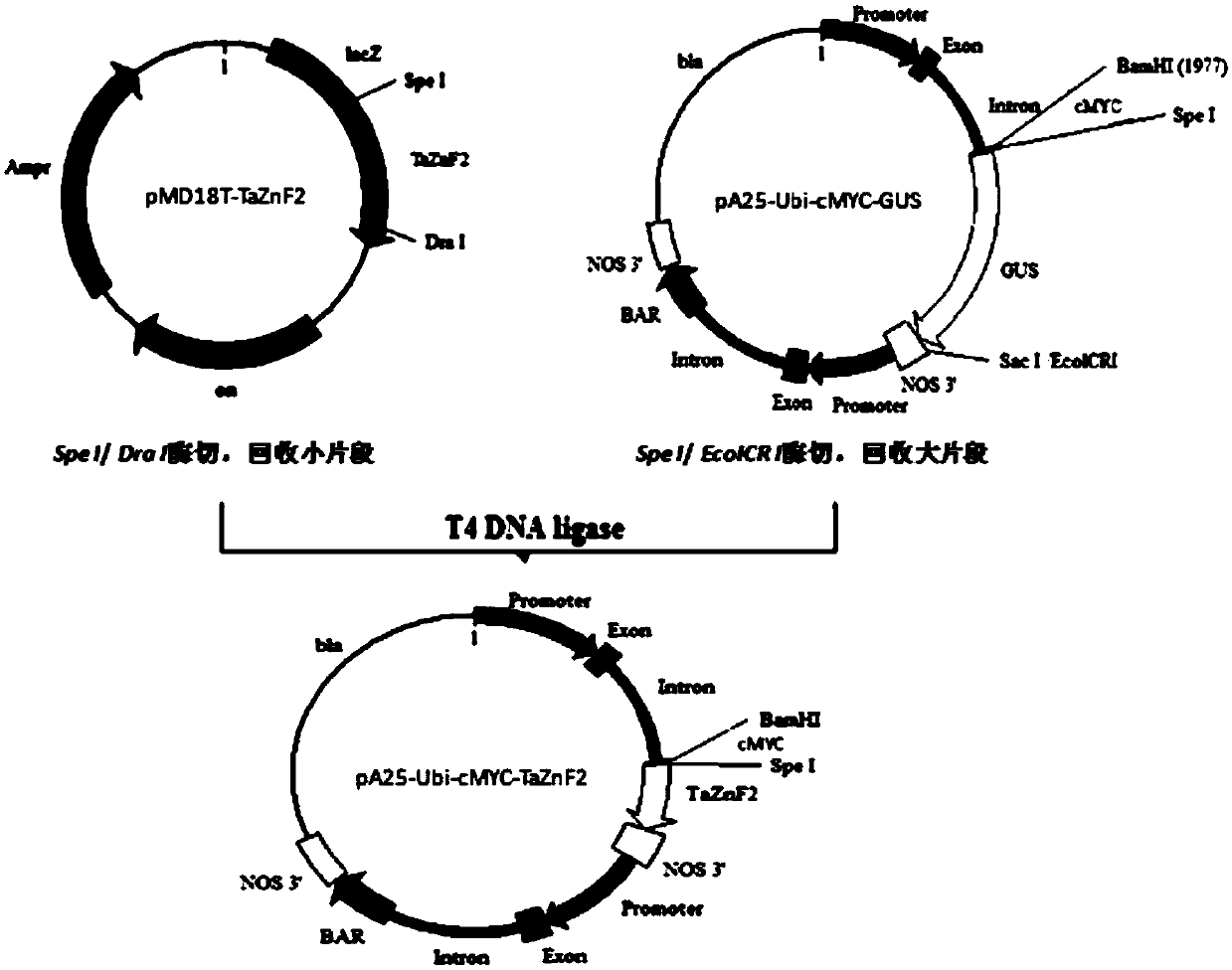Wheat disease resistance proteins and coding genes and their application in regulating plant disease resistance
A protein and amino acid technology, applied in applications, plant peptides, genetic engineering, etc., can solve the problems of lack of easy utilization and slow progress of wheat resistant to sheath blight
- Summary
- Abstract
- Description
- Claims
- Application Information
AI Technical Summary
Problems solved by technology
Method used
Image
Examples
Embodiment 1
[0093] Embodiment 1, the cloning of wheat disease resistance protein TaZnF2 and its coding gene
[0094] The inventors of the present application isolated and cloned a wheat disease resistance protein from sheath blight resistant wheat CI12633, and named it TaZnF2. The specific cloning method of TaZnF2 gene is as follows:
[0095]The total RNA of wheat CI12633 leaf sheath was extracted, and the extracted RNA sample was reverse-transcribed to synthesize the first-strand cDNA according to the procedure of Invitrogen’s first-strand cDNA synthesis kit, which was used as a template for gene cloning, using TaZnF2-3R1:5′-ATTCGGACGAGGAACCCC -3′, 3RACE-Outer Primer: 5′-TACCGTCGTTCCACTAGTGATTT-3′ (Takara), for the first round of PCR amplification. The amplification program was as follows: pre-denaturation at 94°C for 3 minutes; then 35 cycles at 94°C for 45 seconds, 52°C for 45 seconds, and 72°C for 1 minute; extension at 72°C for 10 minutes. The first round of PCR amplification produ...
Embodiment 2
[0105] Example 2, the acquisition of sheath blight resistant transgenic wheat and the identification of disease resistance
[0106] 1. Construction of overexpressed transgene vector
[0107] The complete ORF sequence of the TaZnF2 gene was constructed on the monocotyledonous plant expression vector pAHC25-cMYC, and the construction process was as follows: figure 2 As shown, the specific steps are as follows:
[0108] 1. Preparation of linearized plasmid: Digest the plant expression vector pAHC25-cMYC with Spe I and EcoICR I (is isolytic enzyme with SacI, but produce blunt ends after digestion with EcoICR I), perform 1% agarose gel electrophoresis, agar Glycogel DNA Purification and Recovery Kit to recover the linearized pAHC25-cMYC vector backbone.
[0109] 2. Acquisition of the target gene TaZnF2 containing restriction sites: Design a pair of primers TaZnF2-OT-F: 5′-TAA according to the ORF sequence of the TaZnF2 gene ACTAGT ATGTCGCCGGCGGAGATGGA-3' (the underlined sequen...
Embodiment 3
[0157] Example 3, Breeding Gene-Silenced Wheat with Reduced Sheath Blight Resistance
[0158] 1. The two ends of the DNA fragment shown in the 756th-955th nucleotides of sequence 1 in the sequence listing are respectively provided with the restriction endonuclease NheI recognition sequence. After NheI digestion, the DNA fragment (200bp) shown in the 756-955th nucleotide of sequence 1 in the sequence listing is inserted into the BSMV-γ (the γ vector of BSMV virus) after the NheI enzyme linearization by the reverse insertion method ), the DNA molecule (named antiTaZnF2) that is reverse complementary to the DNA fragment shown in the 756-955 nucleotides of sequence 1 in the sequence listing is driven by the T7 promoter of the gamma vector to obtain the recombinant vector BSMV-γ : anti TaZnF2.
[0159] 2. At the two-leaf one-heart stage, use the recombinant vector BSMV-γ: anti TaZnF2 to transfect the second leaf of the wheat sheath blight-resistant material——wheat CI12633. The spe...
PUM
 Login to View More
Login to View More Abstract
Description
Claims
Application Information
 Login to View More
Login to View More - R&D
- Intellectual Property
- Life Sciences
- Materials
- Tech Scout
- Unparalleled Data Quality
- Higher Quality Content
- 60% Fewer Hallucinations
Browse by: Latest US Patents, China's latest patents, Technical Efficacy Thesaurus, Application Domain, Technology Topic, Popular Technical Reports.
© 2025 PatSnap. All rights reserved.Legal|Privacy policy|Modern Slavery Act Transparency Statement|Sitemap|About US| Contact US: help@patsnap.com



